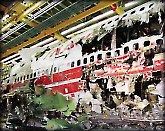
A documentary film called TWA Flight 800 is attracting attention through its claims that the NTSB’s four-year investigation into the 1996 crash included intentionally falsified information and a phony conclusion, and that the case should be reopened — but some key players are, so far, unimpressed. Tom Stalcup, the documentary’s co-producer, says the movie does not explain the explosion of the jet. He told CNN the documentary presents “solid proof that there was an external detonation” and “radar data shows an asymmetric explosion coming out of that plane,” contrary to the findings of investigators. He says the documentary includes six former investigators and eyewitness accounts, and the producers say they intend to file a petition asking the NTSB to reopen the case. TWA Flight 800, a Boeing 747-131, exploded in the air over southern Long Island on July 17, 1996, killing all 230 onboard. Investigators determined the cause of the explosion was a fault common to several other explosions. In response to the documentary the family member of one victim was direct in his criticism of the filmmakers.
“Personal self-fulfilling motives by exploiting those who died on TWA800 is nauseating,” Matt Zimkiewicz, who lost his sister to the flight, told ABC news. Zimkiewicz said both he and his family had “full faith and confidence” in the NTSB’s findings. The NTSB determined that “the crash occurred as the result of a fuel/air explosion in the airplane’s center wing fuel tank,” and the ignition energy “most likely” entered the tank through the fuel quantity indicationsystemwiring. (PDF) The NTSB stated that neither the location of the ignition within the tank, or “the ignitionenergy release mechanism,” could be determined from the available evidence. It also stated, “There was no evidence of a missile or bomb detonation.”Asked why the government would hide a “real” reason for the crash, Stalcup said he refused to speculate. Sources at the NTSB stand by their conclusions and say they are open to any new evidence.
The NTSB’s computer models predicted that, on average, an aircraft would suffer a similar fuel tank explosion every four years. In May 1990, a Philippine Airlines 737-300 had suffered a center-wing fuel tank explosion. In 1996, Flight 800 exploded. In March 2001, a Thai Airways 737-400 exploded while sitting on a hot ramp at Bangkok. In 2006, a Boeing 727-200 suffered a fuel tank explosion in its right wing while the aircraft was on the ground at Bangalore, India. Multiple Airworthiness Directives were issued by the FAA for different Boeing models to address the problem many years after the TWA explosion. Each gave operators years to address the issue. In 2012, some of those directives met formal opposition from airline trade groups, which sought to delay implementation, citing cost concerns.


































